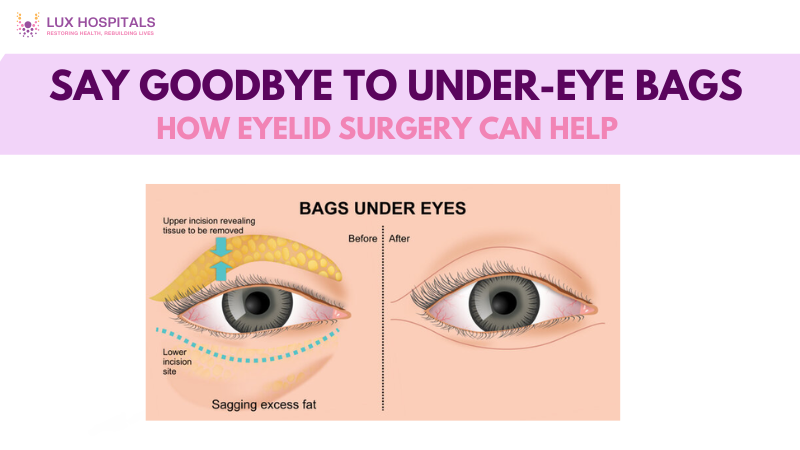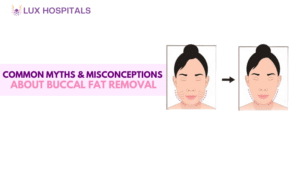Under-Eye Bag Removal with Eyelid Surgery: A Complete Guide

Under-eye bags are a common cosmetic issue that can make you appear older, worn out, or ill. Eyelid surgery, also called blepharoplasty, offers a long-term treatment, whereas lifestyle modifications and skin care products might only provide short-term respite. This blog examines how eyelid surgery can improve looks, reduce under-eye bags, and increase self-esteem. Let’s break down what causes them, how surgery works, and what to expect before and after the procedure.
What Are Under-Eye Bags?
Under-eye bags refer to the puffiness or swelling that develops beneath the eyes. They are usually caused by aging, as the tissues and muscles around the eyes weaken, allowing fat to shift and create a bulge. Fluid retention, lack of sleep, allergies, and genetics also contribute to the formation of under-eye bags.
The appearance includes:
- Puffiness or mild swelling
- Loose or sagging skin
- Dark circles in some cases
Although not typically a health risk, under-eye bags can affect self-esteem and facial aesthetics.
What Is Eyelid Surgery?
Blepharoplasty, sometimes known as eyelid surgery, is a cosmetic procedure that removes excess skin, fat, and muscle from the upper and/or lower eyelids. Lower eyelid surgery targets under-eye bags by tightening skin and repositioning or removing fat deposits. This results in a smoother, firmer, and more youthful under-eye area.
There are two common types:
- Transconjunctival blepharoplasty: No external scar; ideal for fat removal
- External blepharoplasty: Used when skin tightening is needed
Recovery is typically quick, and most people return to daily activities within 1–2 weeks.
Causes of Under-Eye Bags
Understanding the cause of under-eye bags can help determine whether eyelid surgery is the right choice. Common causes include
- Aging: Fat redistributes with age, and collagen production decreases, leading to loose skin.
- Genetics: Some people inherit the tendency to develop puffy eyes.
- Lifestyle Factors: Smoking, alcohol, sleep deprivation, and poor diet can worsen the issue.
- Allergies or Sinus Congestion: These can trigger inflammation and fluid retention.
- Medical Conditions: Thyroid problems and kidney issues may cause swelling under the eyes.
If nonsurgical treatments don’t help, surgery can offer a more permanent fix for under-eye bags.
Benefits of Eyelid Surgery for Under-Eye Bags
Eyelid surgery provides a long-lasting solution to under-eye bags, with benefits beyond aesthetics.
- Rejuvenated Appearance: Makes the face look fresher and more alert.
- Improved Self-Confidence: People often feel better about how they present themselves.
- Minimal Downtime: Most recover within 7–14 days.
- Long-Term Results: Unlike creams and fillers, surgery offers more durable effects.
Patients often look younger and feel more energized after their persistent under-eye bags are eliminated.
Who Is a Good Candidate?
You may be a good candidate for eyelid surgery if:
- You have persistent under-eye bags that are unresponsive to creams or lifestyle changes.
- You’re in good overall health and a non-smoker.
- You have realistic expectations about the results.
During a consultation, your surgeon will examine your facial structure and skin condition and discuss your goals to ensure the procedure is suitable.
What to Expect Before, During, and After Surgery?
Before Surgery:
- Consultation and eye exam
- Blood tests and medical clearance
- Stop smoking and avoid certain medications
During Surgery:
- The procedure takes 1–2 hours
- Local anaesthesia or sedation is used
- Fat and excess skin are removed or repositioned
After Surgery:
- Mild bruising and swelling for 1–2 weeks
- Use cold compresses and keep the head elevated
- Avoid strenuous activities for a few days
Most patients notice a visible reduction in under-eye bags once the swelling subsides.
Risks and Complications
Although eyelid surgery is generally safe, it carries some risks:
- Bruising and swelling
- Infection or bleeding
- Dry or irritated eyes
- Asymmetry or scarring
- Rare complications like vision issues
Choosing a board-certified plastic surgeon significantly reduces the chance of complications and improves outcomes in removing under-eye bags.
Conclusion
If you’re tired of concealing under-eye bags with makeup or creams that offer little improvement, eyelid surgery may be the transformative solution you need. It addresses the root cause by removing excess fat and tightening skin, giving you a refreshed and youthful appearance. With long-lasting results and minimal downtime, it’s an excellent option for anyone looking to reclaim their confidence and say goodbye to under-eye bags for good.
Frequently Asked Questions
Under-eye bags are often caused by aging, which weakens the tissues and muscles around the eyes, allowing fat to shift and fluid to accumulate. Other factors include lack of sleep, allergies, smoking, and genetics. These conditions can all lead to puffiness and sagging beneath the eyes.
Yes, eyelid surgery (lower blepharoplasty) can remove or reposition fat, tighten skin, and provide long-lasting improvement. While it won't stop the natural aging process, results typically last many years. It's considered the most effective way to treat under-eye bags.
Most patients report minimal discomfort, especially with local anesthesia or sedation. During the recovery phase, you may experience mild soreness, tightness, and swelling. Pain is typically managed with prescribed medications or over-the-counter pain relievers.
Initial healing usually takes 7 to 14 days, with most people resuming normal activities within two weeks. Complete healing may take a few months, including scar fading and tissue settling. Following post-op care instructions helps speed up recovery and optimize results.
Yes, non-surgical options include creams with retinol or caffeine, dermal fillers, laser therapy, and microneedling. These may temporarily reduce the appearance of under-eye bags, especially if they are mild. However, they do not provide the long-term results that surgery offers




















